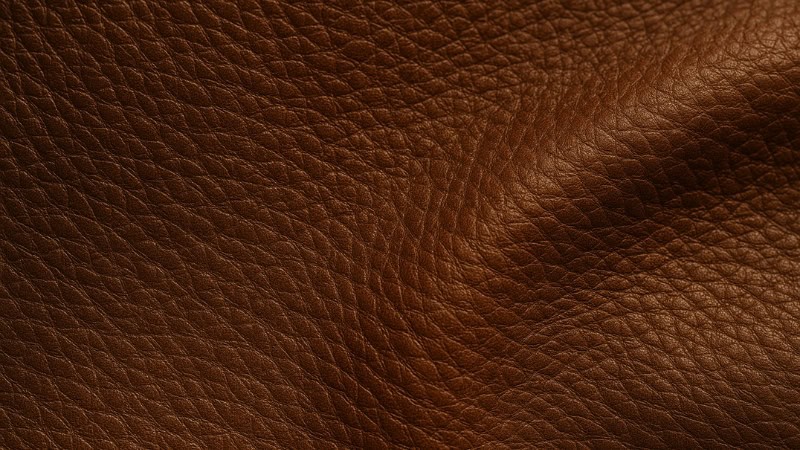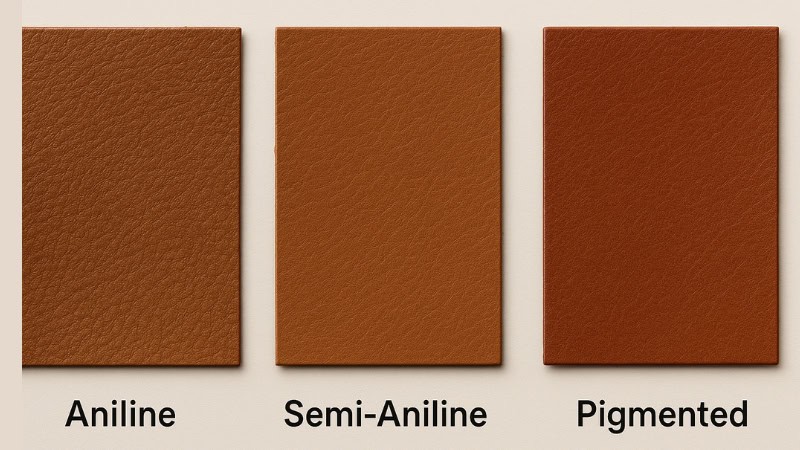Aniline leather is one of the most natural and luxurious leathers in the world. Its soft texture, rich color depth, and genuine grain make it instantly recognizable.
Unlike heavily coated leathers, it keeps its original personality—every mark, pore, and variation tells a story. That’s why designers and collectors love it.
But with its beauty comes sensitivity. Aniline leather needs care, attention, and the right conditions to age gracefully.
If you’ve ever wondered what makes this premium material so special, this guide breaks it all down in simple, conversational language you can trust.
What Is Aniline Leather?
Aniline leather is the purest, most natural form of leather—valued for its softness, rich color, and authentic grain. It’s a luxurious material often found in premium furniture, high-end handbags, and heritage-quality leather goods. This section breaks down what makes it unique, why it’s considered a premium choice, and where it fits in today’s leather categories.
- Aniline leather keeps the natural grain intact, meaning every mark, pore, and variation remains visible. This gives it a raw, organic beauty that artificial finishes can’t replicate.
- It’s dyed with transparent aniline dyes, allowing color to soak deeply into the hide without masking its surface. This process creates warm, earthy tones and a rich patina over time.
- Because it’s minimally processed, aniline leather is exceptionally soft and breathable—but also more sensitive to stains, sunlight, and everyday wear. It’s loved for comfort but requires thoughtful care.
Together, these traits make aniline leather a sought-after material for anyone who appreciates authenticity and craftsmanship. With the basics in place, let’s move into how this premium leather is actually made and why its production sets it apart from other leather types.
How Aniline Leather Is Made
The creation of aniline leather starts with selecting the highest-quality hides. Only top-tier full-grain leather qualifies because the process doesn’t hide imperfections. This section walks you through how these hides are transformed into one of the most luxurious leather types available.
- It begins with premium full-grain hides, chosen specifically for their naturally beautiful surface. Since no thick pigments will cover flaws, only the cleanest hides make the cut.
- Next comes the tanning process, often using vegetable or chrome methods to stabilize the hide and prepare it for dyeing.
- Then the leather is soaked in pure aniline dyes, which penetrate deeply without coating the grain. The transparency of these dyes enhances natural texture and delivers rich, organic color variations.
- No protective topcoat is added, leaving the leather supple, warm to the touch, and beautifully breathable.
Because this process preserves rather than masks the hide’s personality, every piece of aniline leather is visually unique. Now that you know how it’s made, let’s look at the traits that make it so desirable—and so distinctive.
Key Characteristics of Aniline Leather
Aniline leather stands out for its natural look, soft feel, and breathable surface. These features work together to create a premium experience unmatched by heavily finished leathers.
- Its natural grain remains fully visible, from subtle pores to organic markings. This is what gives aniline leather its “authentic” look—nothing is hidden.
- The texture is buttery-soft and warm, thanks to the absence of heavy coatings. This tactile comfort is a major reason luxury brands choose aniline leather.
- It’s highly breathable, allowing air and moisture to move through the hide. This contributes to comfort and helps the material age gracefully.
- Color depth varies beautifully, with slight tonal shifts that make every hide one-of-a-kind.
These characteristics create an unmistakable luxury feel—but they also influence durability. With that in mind, it’s time to explore the different types of aniline leather available today.
Types of Aniline Leather
Aniline leather comes in three main variations, each offering a balance between beauty, softness, and durability. Understanding the differences helps you choose the right one for your lifestyle.
- Pure Aniline Leather
This is the most natural and luxurious version. It has no protective coating, so its grain and color appear raw and organic. While visually stunning, it’s also the most delicate. - Semi-Aniline Leather
Semi-aniline hides receive a very light protective finish. This makes them more resistant to spills and fading while preserving the natural grain. They’re a great middle-ground option for homes with moderate use. - Pull-Up Aniline Leather
Treated with oils or waxes, pull-up leather compresses and lightens in color when stretched. This creates dynamic shading and a rugged, distressed charm that develops character over time.
Each type brings its own personality to the table. Now that we’ve explored these variations, let’s look at why so many people love choosing aniline leather in the first place.
Benefits of Aniline Leather
The main appeal of aniline leather lies in its unmatched beauty, comfort, and ability to age gracefully. These qualities have made it a favorite for premium furniture, bags, and heritage-quality goods.
- Its natural grain and transparency create luxurious aesthetics, giving products a timeless, organic appeal.
- The softness is unbeatable, making it comfortable for everyday use, especially in seating and apparel.
- It develops a rich patina, meaning it becomes even more beautiful with age—something collectors appreciate.
- The breathable finish enhances comfort, preventing the stiff or plastic-like feel seen in heavily coated leathers.
These advantages make aniline leather feel like a long-term investment in quality and style. Of course, with beauty comes responsibility—so let’s explore the challenges that accompany these benefits.
Drawbacks of Aniline Leather
Despite its luxurious qualities, aniline leather isn’t the right fit for everyone. Its natural finish brings unique sensitivities that potential buyers should understand.
- It scratches easily, as the surface has no protective pigment coating. Even simple friction can leave marks.
- Spills and stains soak quickly, because the leather readily absorbs liquids and oils.
- Sunlight and heat can fade the color, especially in light or natural tones.
- Regular maintenance is required, including conditioning and careful cleaning.
These limitations aren’t dealbreakers—but they do mean aniline leather needs thoughtful placement and care. Next, let’s look at where this luxurious material shines the most.
Common Uses of Aniline Leather
Aniline leather is most often found in premium products where natural beauty and softness matter. Its luxurious aesthetic makes it a favorite across industries.
- High-end furniture, such as sofas, armchairs, and recliners, where comfort and elegance take priority.
- Luxury handbags and accessories, which benefit from the material’s character and organic appeal.
- Premium footwear, especially boots and dress shoes that develop attractive patinas.
- Selective automotive interiors, used in upscale vehicles seeking a refined, warm cabin feel.
Aniline leather’s versatility makes it a go-to for designers who value authenticity. To keep these items looking their best, proper care becomes essential—so let’s dive into maintenance next.
How to Care for Aniline Leather
Aniline leather requires gentle, consistent care to maintain its beauty and longevity. The right approach keeps the hide soft, moisturized, and protected against daily wear.
- Dust and wipe regularly using a soft, dry cloth to prevent buildup.
- Apply leather conditioner every few months to keep moisture balanced and prevent cracking.
- Keep it away from harsh sunlight, heaters, and air vents to avoid fading or drying.
- Use only approved cleaners, avoiding household chemicals or abrasive products.
- Blot spills immediately, never rubbing, to minimize staining.
A little routine care goes a long way. Once you know how to maintain aniline leather, it becomes easier to spot the differences between it and other leather types—so let’s break down that comparison.
Aniline vs. Semi-Aniline vs. Pigmented Leather
The main differences among leather types come down to appearance, durability, and maintenance needs. Understanding these distinctions helps you choose wisely.
- Aniline Leather: Most natural, softest, most breathable, but least resistant to stains.
- Semi-Aniline Leather: Light protective coating, good balance between authenticity and durability.
- Pigmented (Protected) Leather: Fully coated with pigments, very durable, uniform in color, and easiest to maintain.
This comparison highlights your trade-off: choose raw beauty (aniline), balanced performance (semi-aniline), or high durability (pigmented). Now, let’s look at how to identify aniline leather in the real world.
How to Identify Aniline Leather
Recognizing aniline leather becomes easy once you know what to look for. Its natural finish offers telltale traits.
- Check the label, as many manufacturers specify “full aniline” or “pure aniline.”
- Look for visible grain, with natural markings and subtle imperfections.
- Feel the surface, which should be warm, soft, and less slippery than coated leather.
- Observe color variations, which appear more organic and less uniform.
Spotting these characteristics helps confirm authenticity. Now that you know how to identify it, let’s talk about who should—and shouldn’t—choose aniline leather.
Who Should Choose Aniline Leather?
Aniline leather is ideal for people who value character, softness, and natural aesthetics. But it’s not for every household.
- Choose it if you appreciate natural beauty, unique grain patterns, and a leather that improves over time.
- It’s great for low-traffic homes, collectors, or anyone who enjoys premium materials.
- It’s not ideal for homes with pets or kids, where spills and scratches are common.
- Semi-aniline may be a better choice if you want a blend of authenticity and practicality.
Now that the core information is covered, let’s shift into common questions people often ask about aniline leather.
FAQs About Aniline Leather
1. Is aniline leather real leather?
Yes, aniline leather is real full-grain leather—the highest-quality leather available. It’s minimally processed, which keeps its grain intact. This makes it more authentic but also more delicate than coated leathers.
2. Does aniline leather scratch easily?
Yes, because it has no thick protective coating. Even minor friction can leave marks or scuffs. Many people appreciate these natural signs of wear because they contribute to a rich patina over time.
3. How long does aniline leather last?
With proper care, aniline leather can last decades. Conditioning, protection from sunlight, and gentle cleaning play a big role. Over time, it develops character rather than wearing out quickly.
4. Can you clean aniline leather at home?
Yes, but only with the right products. Use gentle, leather-specific cleaners and avoid household chemicals. For major stains, professional cleaning may be needed due to the leather’s absorbent nature.
5. Is aniline leather waterproof?
No, it’s not waterproof—and it’s not naturally water-resistant either. Water can darken or stain the surface, so spills should be blot-dried immediately. Conditioning helps but doesn’t make it waterproof.
6. Is aniline leather good for furniture?
It’s excellent for premium furniture in low- to moderate-traffic environments. Its softness and natural beauty make it a favorite in luxury interiors. However, it needs thoughtful placement and care to stay beautiful.
7. What colors does aniline leather come in?
Because aniline dyes are transparent, colors tend to be rich, earthy, and organic. You’ll often see chocolate, tan, cognac, burgundy, and olive tones. Lighter colors are beautiful but require extra care.
The Beauty of Pure Aniline Leather
Aniline leather is a material that celebrates authenticity. It’s soft, natural, luxurious, and full of character—perfect for people who appreciate craftsmanship and unique beauty.
While it requires care, the reward is a leather that ages gracefully and tells its own story over time. For many, that’s exactly what makes aniline leather worth choosing.



